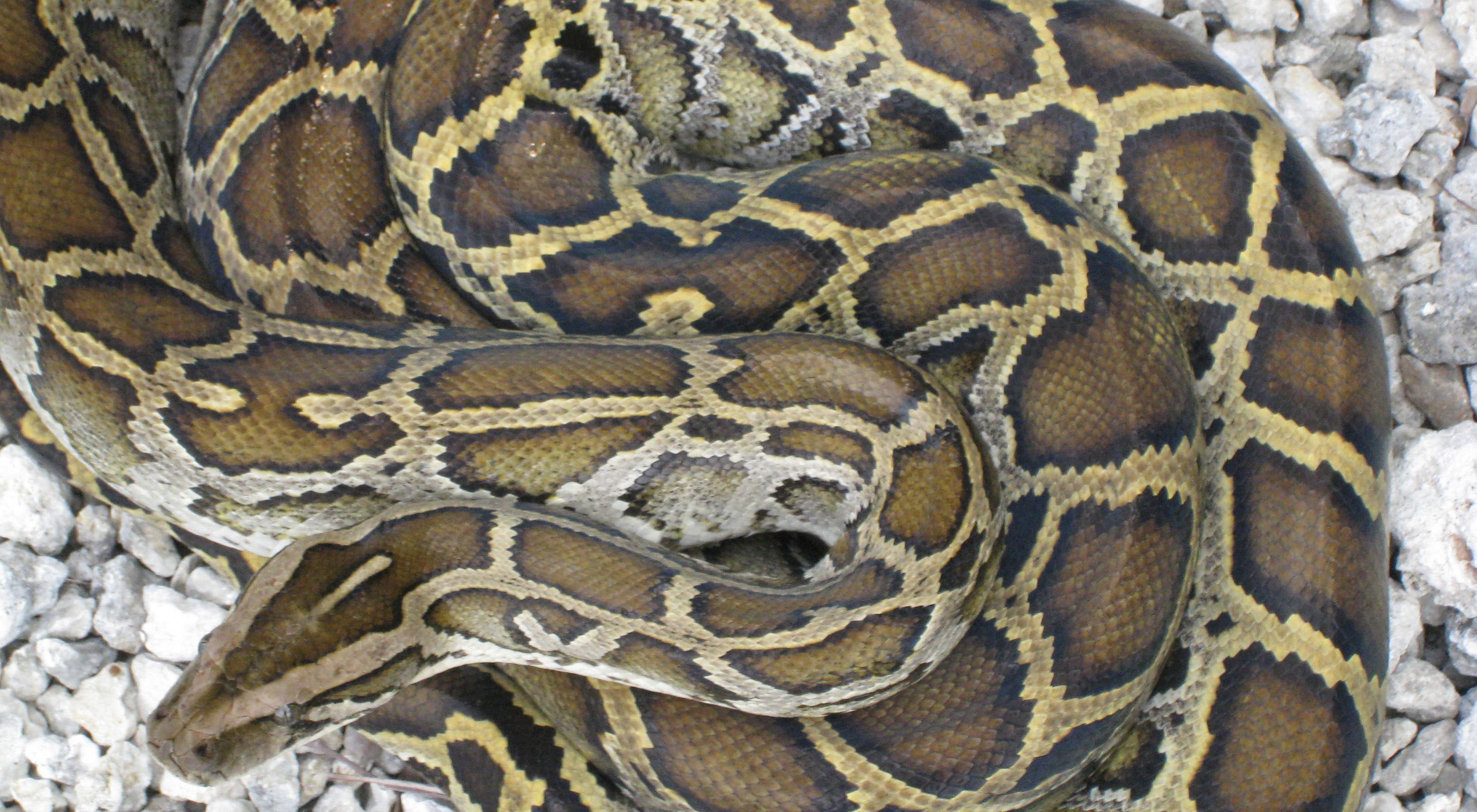Burmese pythons are causing havoc in Florida’s ecosystem. These invasive snakes can grow up to 26 feet long and weigh over 200 pounds, and they’re swallowing up native species at an alarming rate. But don’t worry, there are steps you can take to stop them in their tracks.
In this article, we will explore the different methods used to control and eradicate Burmese pythons in Florida. From trapping to hunting, we’ll dive into the pros and cons of each approach and provide tips for staying safe while doing so. So let’s get started and learn how to put an end to the Burmese python invasion!
To stop Burmese pythons in Florida, you can take the following steps:
- Eliminate sources of food for the pythons, such as rodents, by securing trash cans and removing bird feeders.
- Report any python sightings to the Florida Fish and Wildlife Conservation Commission.
- Participate in python removal programs and hunts.
- Avoid releasing exotic pets into the wild, as they can become invasive species.

How to Stop Burmese Pythons in Florida?
Florida’s Everglades National Park is home to a large number of invasive species, but none have been as destructive as the Burmese python. These snakes, which are native to Southeast Asia, were first introduced to the Everglades in the 1980s through the exotic pet trade. Since then, they have been wreaking havoc on the local ecosystem, preying on native species and disrupting the delicate balance of the food chain.
Why are Burmese Pythons a Problem in Florida?
Burmese pythons are apex predators and have no natural predators in Florida. They are able to grow up to 20 feet long and weigh over 200 pounds, making them capable of preying on a wide range of animals, including deer, alligators, and even panthers. Their voracious appetite has led to a decline in many native species, including rabbits, raccoons, and bobcats, which are important prey for other predators in the ecosystem.
In addition to their impact on the food chain, Burmese pythons also pose a threat to humans. While they are not venomous, they are powerful constrictors and have been known to attack and kill people in other parts of the world.
What is Being Done to Stop Burmese Pythons?
The Florida Fish and Wildlife Conservation Commission has been working to control the population of Burmese pythons in the Everglades. One method is to encourage people not to release exotic pets into the wild, which is how the pythons were first introduced to the area. The commission also holds an annual Python Challenge, which encourages hunters to capture and remove as many pythons as possible.
Researchers are also looking into new methods to control the python population. One promising method is the use of specially trained dogs, which are able to locate and capture pythons more efficiently than humans.
Benefits of Controlling the Burmese Python Population
Controlling the population of Burmese pythons in Florida is crucial for maintaining the balance of the local ecosystem. By reducing the number of pythons, the population of native species can recover, which in turn benefits other predators in the food chain. It also reduces the risk of attacks on humans and pets.
In addition, controlling the python population is important for the economy of the region. The Everglades is a popular tourist destination, and the presence of pythons can deter visitors and harm local businesses.
Challenges in Controlling the Python Population
Controlling the population of Burmese pythons is a difficult task. The snakes are elusive and can be difficult to find, even with the help of trained dogs. In addition, the Everglades is a vast and remote area, making it challenging for hunters and researchers to access.
There is also concern about the impact of control methods on other species in the ecosystem. For example, using poison to kill pythons could harm other animals that feed on the same prey.
Alternatives to Controlling the Python Population
Some researchers are exploring alternative methods to controlling the python population, such as using contraceptives to reduce the number of eggs laid by female pythons. This method has been successful in controlling populations of other invasive species, but it is still in the experimental phase for Burmese pythons.
Another alternative is to focus on reducing the demand for exotic pets, which is the main source of new introductions of pythons into the Everglades. Educating the public about the risks and legal consequences of releasing pets into the wild could help reduce the number of pythons in the area.
Conclusion
The Burmese python population in Florida’s Everglades is a serious problem that requires urgent attention. While there are challenges to controlling the population, there are also promising methods being developed. By working together to reduce the number of pythons, we can protect the local ecosystem and ensure the safety of humans and pets.
Frequently Asked Questions
Florida is facing a significant problem with the invasive Burmese Python population. Here are some frequently asked questions about how to stop Burmese Pythons in Florida.
What are Burmese Pythons, and Why are They a Problem in Florida?
Burmese Pythons are large snakes that are not native to Florida. They were introduced to the area through the pet trade and have become an invasive species. The problem with these snakes is that they have no natural predators in the region and can reproduce rapidly, leading to a significant impact on the local ecosystem. They also pose a risk to human safety, as they are capable of attacking and killing people.
To stop the spread of Burmese Pythons in Florida, it is essential to develop effective management strategies that can help to control their population and prevent them from spreading to new areas.
How Can People Help to Stop the Spread of Burmese Pythons?
There are several things that people can do to help stop the spread of Burmese Pythons in Florida. One of the most important steps is to avoid releasing exotic pets into the wild. This can help to prevent the introduction of new invasive species and reduce the impact of existing ones. It is also essential to report any sightings of Burmese Pythons to the authorities so that they can be captured and removed from the area.
Additionally, people can support organizations that are working to address the problem of invasive species in Florida. These groups work to develop and implement management strategies that can help to control the population of Burmese Pythons and other invasive species in the region.
What Management Strategies are Being Used to Control the Population of Burmese Pythons?
There are several management strategies that are being used to control the population of Burmese Pythons in Florida. One approach is to use trained dogs to locate the snakes, which can then be captured and removed from the area. Another method is to use traps to catch the snakes, which are then either relocated or euthanized.
Some researchers are also exploring the use of genetic tools to help control the population of Burmese Pythons. For example, they are examining the possibility of introducing a gene that would cause female snakes to produce only male offspring, which could help to reduce the number of breeding females in the population.
What are the Challenges in Controlling the Population of Burmese Pythons?
There are several challenges in controlling the population of Burmese Pythons in Florida. One of the biggest obstacles is the sheer size and scope of the problem. The snakes have already established a significant presence in the region, and their population continues to grow. Additionally, the snakes are highly adaptable and can thrive in a variety of habitats, making them difficult to control.
Another challenge is the cost of implementing management strategies. Capturing and removing Burmese Pythons can be expensive and time-consuming, and there is a limited amount of funding available for these efforts. Finally, there is also the risk of unintended consequences associated with any management strategy, such as the impact on non-target species or the development of resistance to control methods.
What is Being Done to Address the Problem of Burmese Pythons in Florida?
There are several initiatives underway to address the problem of Burmese Pythons in Florida. One approach is to increase public awareness of the issue and encourage people to report sightings of the snakes. There are also ongoing efforts to develop and implement effective management strategies, such as the use of trained dogs and genetic tools.
In addition, there are several organizations dedicated to addressing the problem of invasive species in Florida. These groups work to educate the public, conduct research, and develop management strategies that can help to control the population of Burmese Pythons and other invasive species in the region.
The Bounty Hunters Catching Pythons In Florida (HBO)
In conclusion, stopping Burmese pythons in Florida is a significant challenge, but it is not impossible. With the right strategies and collaborative efforts, we can effectively control their population and prevent further damage to our ecosystem.
Firstly, we need to focus on early detection and rapid response. This means training field personnel, increasing surveillance, and implementing effective management plans to prevent the spread of these invasive species.
Secondly, education and outreach programs can play a crucial role in raising awareness about the dangers of releasing non-native species into the wild. This can help prevent future introductions and reduce the number of pythons in the state.
Finally, continued research and innovative solutions can also help us tackle this issue. From using technology to tracking and removing pythons to developing effective control methods, we must remain committed to finding new solutions to this problem.
By working together and taking action, we can protect Florida’s unique ecosystem and preserve its natural beauty for generations to come.


